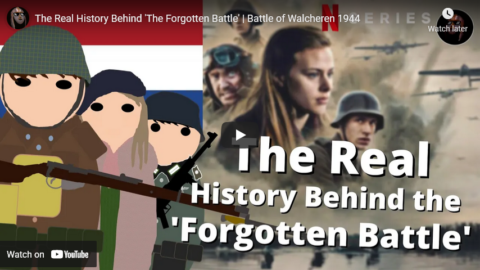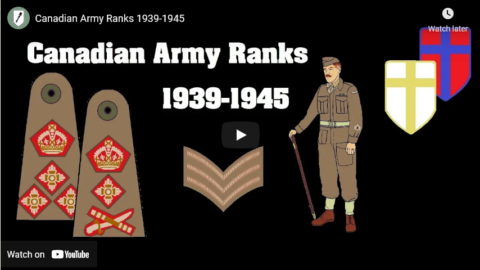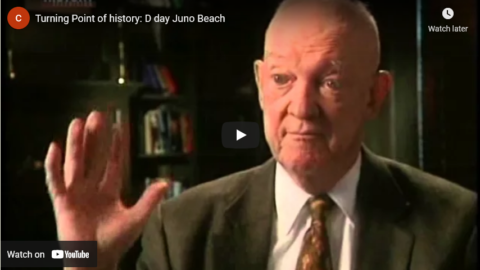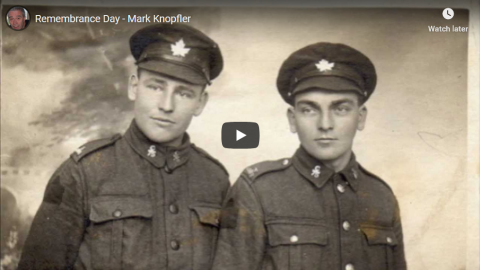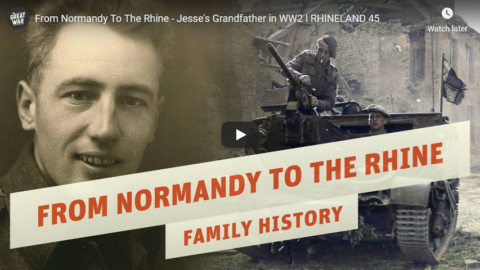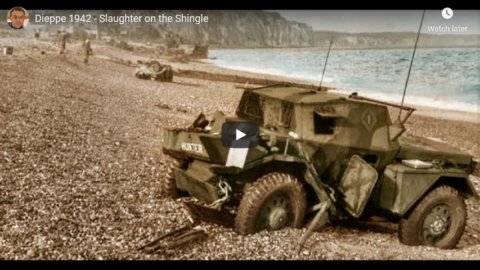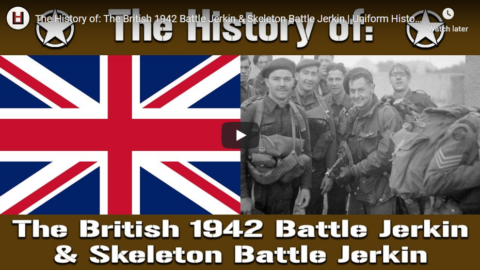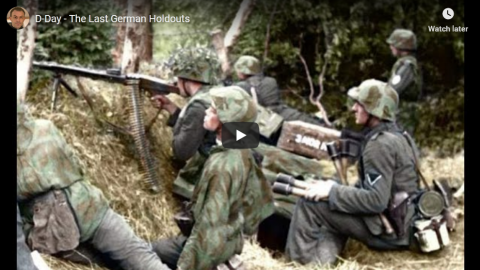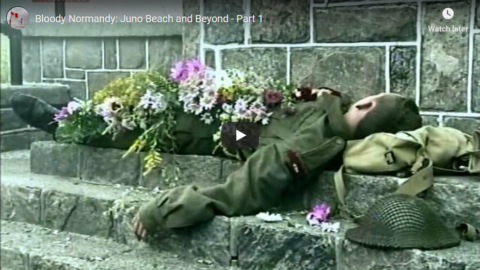History With Hilbert
Published 10 Nov 2021The Forgotten Battle is a Dutch/Belgian Netflix war film set during the Battle of Walcheren in 1944, part of the Liberation of the Netherlands from German control following the successful D-Day landings of the Allies. In this video I look at the history of the Battle of the Scheldt and in particular the assault on Walcheren, as well as some of the other historical aspects covered by the film such as Dutchmen who served in the Waffen SS on the Eastern Front and the Dutch Resistance (De Ondergrondse) who fought against the German occupiers and aided the Allies in their push into the Netherlands.
@History Hustle’s excellent videos on Dutch Waffen SS units:
https://www.youtube.com/watch?v=bQlF0…Go Fund My Windmills (Patreon):
https://www.patreon.com/HistorywithHi…Join in the Banter on Twitter:
https://twitter.com/HistorywHilbertIndulge in some Instagram..?(the alliteration needs to stop):
https://www.instagram.com/historywith…0:00 – Intro
3:00 – Walcheren Remains In German Hands
4:14 – The Battle of Walcheren Causeway
6:18 – Operation Infatuate I & II
8:00 – Walcheren Is Captured
8:47 – Dutchmen Serving in the SS
10:18 – The Dutch Resistance In World War 2
13:04 – OutroSend me an email if you’d be interested in doing a collaboration! historywithhilbert@gmail.com
#WW2 #Netherlands #Netflix
November 17, 2021
The Real History Behind The Forgotten Battle | Battle of Walcheren 1944
August 23, 2021
Canadian Army Ranks 1939-1945
HandGrenadeDivision
Published 6 Sep 2019A brief video describing the ranks used by the Canadian Army in the Second World War, with an equally brief introduction to the General Staff system.
Further reading and resources regarding the Canadian Army of the Second World War:
Service Publications
canadiansoldiers.com
http://www.canadiansoldiers.com
Department of National Defence Directorate of History and Heritage
June 6, 2021
Turning Point of History: D-Day Juno Beach
ch1201
Published 8 Nov 2014Examines Canada’s role on June 6th, 1944 and the advance through Normandy, France.
November 11, 2020
Mark Knopfler – “Remembrance Day”
Bob Oldfield
Published on 3 Nov 2011A Remembrance Day slideshow using Mark Knopfler’s wonderful “Remembrance Day” song from the album Get Lucky (2009). The early part of the song conveys many British images, but I have added some very Canadian images also which fit with many of the lyrics. The theme and message is universal… “we will remember them”.
September 25, 2020
From Normandy To The Rhine – Jesse’s Grandfather in WW2 I RHINELAND 45
The Great War
Published 23 Sep 2020Back Rhineland 45: https://realtimehistory.net/rhineland45
Jesse shares the service history of his grandfather James who fought in the Canadian Army.
Contains licensed material by getty images
All rights reserved – Real Time History GmbH 2020
August 19, 2020
Dieppe 1942 – Slaughter on the Shingle
Mark Felton Productions
Published 14 Mar 2020Find out how and why the Dieppe Raid was launched in 1942 and why is went so disastrously wrong.
Visit my new audio book channel ‘War Stories with Mark Felton’: https://youtu.be/xszsAzbHcPE
Help support my channel:
https://www.paypal.me/markfeltonprodu…
https://www.patreon.com/markfeltonpro…Disclaimer: All opinions and comments expressed in the ‘Comments’ section do not reflect the opinions of Mark Felton Productions. All opinions and comments should contribute to the dialogue. Mark Felton Productions does not condone written attacks, insults, racism, sexism, extremism, violence or otherwise questionable comments or material in the ‘Comments’ section, and reserves the right to delete any comment violating this rule or to block any poster from the channel.
Credits: YouTube Creative Commons; WikiCommons; Google Commons; Mark Felton Productions
July 3, 2020
The History of: The British 1942 Battle Jerkin & Skeleton Battle Jerkin | Uniform History
Uniform History
Published 24 Mar 2020The start of another two parter, in this one we cover the British Battle Jerkin family as it helped inspire the US Normandy Assault Vest’s creation.
Music by: https://www.juliancrowhurst.com/
June 8, 2020
D-Day – The Last German Holdouts
Mark Felton Productions
Published 6 Jun 2020Some German coast defences managed to survive on D-Day and fought on behind Allied lines. One was the massive Douvres Radar Station bunker complex between Juno and Sword Beaches. It held out for 12 days after D-Day, and required a special operation to knock it out.
Visit my audio book channel ‘War Stories with Mark Felton’: https://youtu.be/xszsAzbHcPE
Help support my channel:
https://www.paypal.me/markfeltonprodu…
https://www.patreon.com/markfeltonpro…Disclaimer: All opinions and comments expressed in the ‘Comments’ section do not reflect the opinions of Mark Felton Productions. All opinions and comments should contribute to the dialogue. Mark Felton Productions does not condone written attacks, insults, racism, sexism, extremism, violence or otherwise questionable comments or material in the ‘Comments’ section, and reserves the right to delete any comment violating this rule or to block any poster from the channel.
Credits: YouTube Creative Commons; WikiCommons; Google Commons; Google Maps; Mark Felton Productions; Sartorlelg
June 6, 2019
Bloody Normandy: Juno Beach and Beyond – Part 1
canmildoc
Published on 17 Sep 2011Part 1 of 5
Documentary “Stories from the Second World War: Bloody Normany”.
Juno or Juno Beach was one of five sectors of the Allied invasion of German-occupied France in the Normandy landings on 6 June 1944, during the Second World War. The sector spanned from Saint-Aubin, a village just east of the British Gold sector, to Courseulles, just west of the British Sword sector. The Juno landings were judged necessary to provide flanking support to the British drive on Caen from Sword, as well as to capture the German airfield at Carpiquet west of Caen. Taking Juno was the responsibility of the 3rd Canadian Infantry Division and commandos of the Royal Marines, with support from Naval Force J, the Juno contingent of the invasion fleet, including ships of the Royal Canadian Navy (RCN). The beach was defended by two battalions of the German 716th Infantry Division, with elements of the 21st Panzer Division held in reserve near Caen.
The invasion plan called for two brigades of the 3rd Canadian Division to land in two subsectors — Mike and Nan — focusing on Courseulles, Bernières, and Saint-Aubin. It was hoped that preliminary naval and air bombardment would soften up the beach defences and destroy coastal strongpoints. Close support on the beaches was to be provided by amphibious tanks of the 2nd Canadian Armoured Brigade. Once the landing zones were secured, the plan called for the 9th Canadian Infantry Brigade to land reserve battalions and deploy inland, the Royal Marine commandos to establish contact with the British 3rd Infantry Division on Sword, and the 7th Canadian Infantry Brigade to link up with the British 50th (Northumbrian) Infantry Division on Gold. The 3rd Canadian Division’s D-Day objectives were to capture Carpiquet Airfield and reach the Caen-Bayeux railway line by nightfall.
The landings initially encountered heavy resistance from the German 716th Division; the preliminary bombardment proved less effective than had been hoped, and rough weather forced the first wave to be delayed until 07:35. Several assault companies — notably those of the Royal Winnipeg Rifles and The Queen’s Own Rifles of Canada — took heavy casualties in the opening minutes of the first wave. Strength of numbers, as well as coordinated fire support from artillery and armoured squadrons, cleared most of the coastal defences within two hours of landing. The reserves of the 7th and 8th brigades began deploying at 08:30 (along with the Royal Marines), while the 9th Brigade began its deployment at 11:40.
The subsequent push inland towards Carpiquet and the Caen-Bayeux railway line achieved mixed results. The sheer numbers of men and vehicles on the beaches created lengthy delays between the landing of the 9th Brigade and the beginning of substantive attacks to the south. The 7th Brigade encountered heavy initial opposition before pushing south and making contact with the 50th Infantry Division at Creully. The 8th Brigade encountered heavy resistance from a battalion of the 716th at Tailleville, while the 9th Brigade deployed towards Carpiquet early in the evening. Resistance in Saint-Aubin prevented the Royal Marines from establishing contact with the British 3rd Division on Sword. When all operations on the Anglo-Canadian front were ordered to halt at 21:00, only one unit had reached its D-Day objective, but the 3rd Canadian Infantry Division had succeeded in pushing farther inland than any other landing force on D-Day. – http://en.wikipedia.org/wiki/Juno_beach
April 17, 2019
Tank Chats #46 Ram Kangaroo | The Funnies | The Tank Museum
The Tank Museum
Published on 16 Feb 2018As part of the Funnies mini-series, David Fletcher takes a look at the troop-carrying Ram Kangaroo.
Towards the end of World War Two, Canadian Ram tanks were converted into Armoured Personnel Carriers called Kangaroos.
Support the work of The Tank Museum on Patreon: ► https://www.patreon.com/tankmuseum
Or donate http://tankmuseum.org/support-us/donateVisit The Tank Museum SHOP: ►https://tankmuseumshop.org/
Twitter: ► https://twitter.com/TankMuseum
Tiger Tank Blog: ► http://blog.tiger-tank.com/
Tank 100 First World War Centenary Blog: ► http://tank100.com/ #tankmuseum #tanks
June 6, 2018
D-Day: Canada at Juno Beach
Yesterday Today
Published on 3 Jun 2017D-Day: Canada at Juno Beach
6 June 1944
Of the nearly 150,000 Allied troops who landed or parachuted onto the Normandy coast, 14,000 were Canadians. They assaulted a beachfront code-named “Juno”.
The Royal Canadian Navy contributed 110 ships & 10,000 sailors in support of the landings while the RCAF had helped prepare the invasion by bombing targets inland. On D-Day & during the ensuing campaign, 15 RCAF fighter & fighter-bomber squadrons helped control the skies over Normandy and attacked enemy targets. On D-Day, Canadians suffered 1074 casualties, including 359 killed.
April 15, 2018
Canada’s military – the difference between fighting wars in the 20th Century and fighting wars today
 In a post from earlier this week about defence spending priorities for the Canadian military, Ted Campbell looks at how wars changed between the first half of the 20th century and the post-Cold War situation we face today:
In a post from earlier this week about defence spending priorities for the Canadian military, Ted Campbell looks at how wars changed between the first half of the 20th century and the post-Cold War situation we face today:
Is the 2% goal wrong?
No … it’s a pretty sensible level of defence spending for countries that really want to maintain a world at peace, as opposed to those, like Canada and many of its allies, that just want to hope for peace. But 2% is not a magic bullet … 1.5% of GDP, spent carefully, will do more than 2% spent as a job creation slush fund. But spending too little, cutting defence spending again and again and again just because it is unpopular can leave a country with what I have described as a Potemkin Village, a military that is more show than force.
The advent of a nuclear face-off circa 1950 changed the strategic calculus for the rest of the 20th century. We suddenly had the “come as you are war” which meant having regular, professional forces in being and not being able to rely upon time and space to give us time, as we had in past wars, to mobilize our reserves. We would do well, 101 years after the battle of Vimy Ridge, to recall that it, in April 1917, was the first time since war was declared (in the summer of 1914) that the full Canadian Corps, of four infantry divisions, was in battle as a corps ~ it took us over 30 months to get from a tiny standing army backed by small but eager reserves to a full corps composed of about 100,000 of the Canadians who served overseas during that war. We went to war again in the late summer of 1939 and it was not until the summer of 1943, over 40 months later, that we had a small corps, of only two divisions and an independent armoured brigade, in battle, in Italy. It takes a long time to mobilize and equip and train an army. The operational doctrine of the long and expensive cold war said that we could no longer have that time.
It is not clear that we must or even should still have small reserves and a relatively larger permanent force. Perhaps the time has come to re-examine the assumptions that underlie our force structure ideas. Maybe we need 150,000 uniformed people but, maybe, the split should be 50/50 or 75,000 full time and 75,000 part time sailors, soldiers and air force members. Maybe a country like Canada, with a population that will, in 2050, approach 40 million, should have a larger force: say 75,000 full time and even 150,000 part time military members … maybe our reserve force “regiments’ should have 500 or 750 soldiers and be required to “generate” a trained company (125 soldiers) rather than having only 150 soldiers and being hard pressed to “generate” a platoon of only 30 soldiers. I have my own ideas, but someone who has the necessary information at their disposal needs to look ahead at our strategic situation and develop a force model and a sane budget for 2050. That should be a job for skilled civil servants in the defence policy staff.
Our strategic priorities for the next 30 years or more need to be:
- Containing and reducing threats to global peace and security by helping to maintain alliances like NATO and groupings like AUSCANNZUKUS and supporting global peacemaking and peacekeeping efforts, even the generally worthless United Nations efforts;
- Confronting current threats to peace ~ like Russia ~ and deterring (by matching the growth in military power of) potential future threats ~ like China;
- Cooperating with the USA in the protection of North America; and
- Securing the land we claim as our own, the waters contiguous to it and the airspace over both.
When we work out the costs, of people, above all, but also of ships, tanks, guns and aircraft, and of ammunition, food and fuel and everything else, of doing those four things ~ and of doing them well enough ~ then we will know what what sort of forces we need and how much we must budget to build and maintain them. But no matter what the size and what the cost, I guarantee that people will still be the biggest single expense if we keep our priorities straight: and the overarching priority is that people cost more than machines because they matter more than machines.
August 23, 2017
One definite success from the Dieppe raid
The allied attack on Dieppe in August, 1942 was an operational failure: nearly 60% of the raiding force were killed, wounded or captured and the tactical objectives in the harbour area were not achieved. I’ve mentioned the speculations on an Enigma side-operation (which does not seem to be given credence by most historians), using the main Canadian attack as cover for an attempt to snatch the latest German encryption device from one or more high-security locations within the target area. A second side-mission was also conducted to capture one of the newest German radar stations at Pourville, just down the coast from Dieppe:
Aerial reconnaissance photos indicated that one of these new Freya radar sets had been installed at Pourville-sur-Mer, near Dieppe. A military raid on Dieppe, to test British and Canadian plans for an amphibious invasion, was already being planned. Senior officers immediately added a sub-plan to the Dieppe raid: a small force would be detached to attack the Pourville radar station. There, a radar expert would dismantle the station’s vital equipment and transport it back to the UK for analysis.
Nissenthall, a Jewish cockney who had a lifelong fascination with electronics and radio technology, had joined the Air Force as an apprentice in 1936. By the outbreak of the war in 1939 he was assigned to RAF radio direction finding stations (RDF, the short-lived original term for radar) and rapidly built up a reputation as a competent and technically skilled operator. Before the war he had also worked directly with Robert Watson-Watt, widely regarded today as the father of radar.A German FuMG 401 “Freya LZ” radar station of the type installed at Pourville. (US National Archives and Records Administration image, via Wikimedia)
[…]
More than 5,000 soldiers of the First Canadian Division set off from the south coast of England in the early hours of 19 August 1942. Embedded with A Company of the South Saskatchewan Regiment, Nissenthall’s 11-man bodyguard landed on French soil – but on the wrong side of the Scie River from the radar station.
After finding their way to their intended starting point, the team ran into stiff German resistance. Casualties soon mounted up as they probed the area, looking for a way into the radar station.
Thanks to the Bruneval raid six months previously, the Germans had beefed up their defences around coastal radar stations. This, combined with the naivete of the Allied planners back in Britain, had left the Canadians exposed and vulnerable. Though Nissenthall’s team had just about reached the radar station, there was no hope they would be able to get inside it, much less examine it, dismantle it and take away the most valuable parts of the Freya set inside.
August 19, 2017
Dieppe Raid 19 August, 1942 – Assault, escape and aftermath
Published on 22 Mar 2009
The Dieppe Raid was one of the costliest days for the Canadian Army in the entire Second World War. 907 Canadians were killed, in addition more than 2,500 were wounded or captured, all on August 19 of 1942.
At the BBC site: Julian Thompson’s summary of the Dieppe Raid.
October 15, 2015
S.L.A. Marshall, Dave Grossman, and the “man is naturally peaceful” meme
The American military historian S.L.A. Marshall was perhaps best known for his book Men Against Fire: The Problem of Battle Command in Future War, where he argued that American military training was insufficient to overcome most men’s natural hesitation to take another human life, even in intense combat situations. Dave Grossman is a modern military author who draws much of his conclusions from the initial work of Marshall. Grossman’s case is presented in his book On Killing: The Psychological Cost of Learning to Kill in War and Society, which was reviewed by Robert Engen in an older issue of the Canadian Military Journal:
As a military historian, I am instinctively skeptical of any work or theory that claims to overturn all existing scholarship – indeed, overturn an entire academic discipline – in one fell swoop. In academic history, the field normally expands and evolves incrementally, based upon new research, rather than being completely overthrown periodically. While it is not impossible for such a revolution to take place and become accepted, extraordinary new research and evidence would need to be presented to back up these claims. Simply put, Grossman’s On Killing and its succeeding “killology” literature represent a potential revolution for military history, if his claims can stand up to scrutiny – especially the claim that throughout human history, most soldiers and people have been unable to kill one another.
I will be the first to acknowledge that Grossman has made positive contributions to the discipline. On Combat, in particular, contains wonderful insights on the physiology of combat that bear further study and incorporation within the discipline. However, Grossman’s current “killology” literature contains some serious problems, and there are some worrying flaws in the theories that are being preached as truth to the men and women of the Canadian Forces. Although much of Grossman’s work is credible, his proposed theories on the inability of human beings to kill one another, while optimistic, are not sufficiently reinforced to warrant uncritical acceptance. A reassessment of the value that this material holds for the Canadian military is necessary.
The evidence seems to indicate that, contrary to Grossman’s ideas, killing is a natural, if difficult, part of human behaviour, and that killology’s belief that soldiers and the population at large are only being able to kill as part of programmed behaviour (or as a symptom of mental illness) hinders our understanding of the actualities of warfare. A flawed understanding of how and why soldiers can kill is no more helpful to the study of military history than it is to practitioners of the military profession. More research in this area is required, and On Killing and On Combat should be treated as the starting points, rather than the culmination, of this process.

